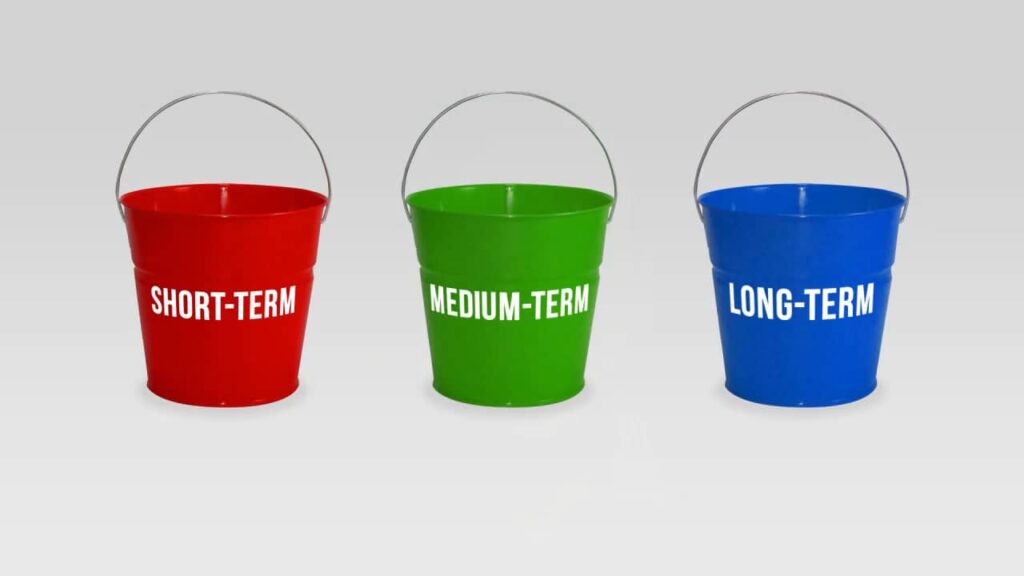At A Glance – Planning your savings for short, medium and long-term goals helps you build stability for your financial future.
In my article, How To Save Money, I talk about saving for short, medium and long-term needs. This strategy for your savings goals helps you build stability in your financial plan for future needs. It gives you tools in your toolbelt to meet the ups and downs of life.
Here is an article written by a friend of mine, Randall Neighbour of Kingdom Wealth Management. He addresses this topic in his Three Bucket Strategy for savings.
The Three Bucket Strategy
The Three Bucket Strategy is a great tool for preparing for your future and thinking about money. It’s a common practice in the financial planning world because it has the potential to foster healthy investment attitudes.
First Bucket – Operating & Emergency Fund
In this first bucket, you should keep enough cash for 3-6 months of living expenses. This money should not be invested but kept in a money market or a checking/savings account. While this bucket’s contents won’t earn much these days, if we experience inflation—and we will experience it sooner or later—then it should start earning more.
Tip: If you need to dip into this first bucket for a genuine emergency (a washing machine repair or an auto repair), imagine you’ve borrowed that money from a loan shark and he will break your kneecaps if you don’t pay it back as soon as possible. Cut back on eating out and expensive coffees or clothing or however you like to spend discretionary money and “top up” your first bucket as soon as possible. Draining it makes this strategy a worthless exercise.
Second Bucket – Near Term Spending Fund For The Next 2-9 Years
In this second bucket, you’ll want to invest money for upcoming needs such as a new roof or replacing a vehicle. Because the timeframe for the investment is relatively short, the money in this bucket should be invested conservatively.
Tip: Fixed instruments such as bonds and CDs could be considered for the second bucket. These investments probably won’t double your money in five years, but that’s OK. If you invest it conservatively, you won’t put yourself in an emotional quandary when a withdrawal is necessary. A conservative investment approach works here because the balance on the account is more predictable and the time horizon is not long enough to recover from a big drop in your investments.
Third Bucket – Long Term Savings For Retirement
In this last bucket, you want to invest for use in ten to thirty years. This is not money you touch unless you are forced to drain the first two buckets due to a financial catastrophe. Because of the duration of the investments in this bucket, you can afford to take more investment risk. After all, there’s time for it to recover if the investments drop in value for a season.
There are bull markets when most investments appreciate and bear markets when many depreciate. Historically, the bulls run longer than the bears and that’s what you’re hoping to achieve with long-term investing. The target use for this bucket’s contents is retirement withdrawals, healthcare costs, long-term care, charitable giving and inheritance.
Tip: Higher future tax rates are a big consideration. For this reason, using a Roth IRA may be an excellent choice for this bucket if you don’t make too much money to max out an annual contribution. However, if you only have Traditional IRA money or 401k money for this bucket today, that’s ok! It’s better to have a big third bucket of taxable money than no third bucket at all.
Which Bucket Should I Fill First?
You need an emergency fund. Build up a month’s worth of your expenses and fund the first bucket with it. If you have consumer debt, then attack your debt with every dollar you can find and get out of debt. When everything but your mortgage is paid off, go back to bucket one and finish filling it with your 3-6 months of living expenses.
“Let’s Go Back To That Second Bucket. Now I Have Questions.”
Everyone has questions here. This second bucket is where you must first consider your NEEDS in the next three to five years and first save for those needs (new roof, replace a car) and then save for your WANTS on top of that amount (European Cruise, taking grandkids to Disney, update the kitchen). And always keep in mind that saving for things you WANT must never reduce the amount you should be putting in your third bucket. Remember this: I have never heard someone say, “I saved and invested too much money when I was in my 50s and 60s.”
“But What About My Mortgage?”
This is a tough question to answer and it’s different for everyone, but there’s a good rule of thumb to follow here: Pay off your mortgage and any other debt before you stop working. Millions of Americans are forced into retirement earlier than expected due to their health or the health of their spouse. For this reason, living lean in your 50s and 60s to pay off all debt is a wise long-term move even if you remain healthy and want to keep working.
In Summary…
I’ve been using the bucket approach with clients for a decade. This approach will help you mentally segment your savings and invest it appropriately. It also helps put both spouses on the same page when it comes to money, spending, and investing.
Now get busy!
Sit down with a paper, pen and calculator. Or, bring up a spreadsheet on your computer. Total what you need in each bucket and why it belongs there. If you need help or have questions, visit with an advisor. Don’t let anything stop you from charting a financial course for your future.
Randall Neighbour is the founder of Kingdom Wealth Management in Houston, Texas. He holds the designations of Retirement Income Certified Professional® and Accredited Portfolio Management Advisor®. To read the original version of this article, follow this web link: https://kingdomwealthmgt.com/the-three-bucket-strategy
Key Takeaway – Planning your savings for short, medium and long-term goals helps you build stability for your financial future.









